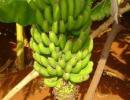 |
Bananas
Scientific name:
Musa spp.
Family:
Zingiberales: Musaceae
Local names:
Banana: Ndizi (Swahili) - Plantain: Matoke (Swahili)
Pests and Diseases: Anthracnose
Aphids
Bacterial wilt
Banana bunchy top disease
Banana weevil
Black leaf streak
Cigar end rot
Fruit flies
Fusarium wilt
Root-knot nematodes
Snails (Giant East African Snail)
Thrips
|
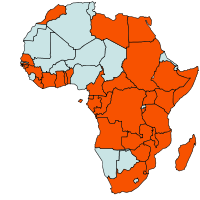 |
| Geographical Distribution of Banana in Africa |
Bananas are perennial tropical plants whose fruits are used both for cooking (plantains) and as table fruits. They may also be processed into starch, chips, purée, beer (in Africa), vinegar, or may be dehydrated and sold as dried fruit. Flour is produced from both plantains and table bananas, which can then be used in soups, baking or as a drink.
The flowers can be used as a vegetable, but they have to be heated briefly in salty water to remove the bitterness. The fresh leaves have a high content of protein and cattle and chicken like them because of their taste. The leaves are also used as packing material and for roofing. Together with the stem (pseudo-stem) it also offers an excellent mulching material. Bananas can also be planted as a windbreak to a vegetable garden. Bananas are a staple food in many of the lower altitude, wetter areas of East Africa. They are mostly grown as a subsistence crop, although there is much internal and regional trading.
Nutritive Value per 100 g of edible Portion
| Raw or Cooked Banana | Food Energy (Calories / %Daily Value*) |
Carbohydrates (g / %DV) |
Fat (g / %DV) |
Protein (g / %DV) |
Calcium (g / %DV) |
Phosphorus (mg / %DV) |
Iron (mg / %DV) |
Potassium (mg / %DV) |
Vitamin A (I.U) |
Vitamin C (I.U) |
Vitamin B 6 (I.U) |
Vitamin B 12 (I.U) |
Thiamine (mg / %DV) |
Riboflavin (mg / %DV) |
Ash (g / %DV) |
| Banana raw | 89.0 / 4% | 22.8 / 8% | 0.3 / 1% | 1.1 / 2% | 5.0 / 1% | 22.0 / 2% | 0.3 / 1% | 358 / 10% | 64.0 IU / 1% | 8.7 / 15% | 0.4 / 18% | 0.0 / 0% | 0.0 / 2% | 0.1 / 4% | 0.8 |
Bananas grow well in fairly hot and humid areas that is within an altitude of 0-1800 m above sea level with the exception of "Dwarf Cavendish" which can grow well up to 2100 m.a.s.l. (metres above sea level). For survival a rainfall of at least 1000 mm per year is necessary, but in order to achieve good yields bananas should receive 200-220 mm water per month as a regular supply. For most commercial banana growers this means irrigating during the dry months. Commercially used varieties cannot endure stagnant water conditions, so flood irrigation should only be used if the soil has good drainage.
Temperature is a major factor; the optimum for growth is about 27°C and the maximum 38°C. Plant growth is retarded and chilling injury occurs below 13°C.
Bananas are sensitive to strong winds, which shred the leaves, cause crown distortions and blows plants over, and are susceptible to lodging in the absence of windbreaks. Planting in wind sheltered positions and in blocks rather than strips is recommended. If planted in blocks the plants protect each other against wind.
The best soil for bananas is a deep, friable loam with good drainage and aeration. High fertility is a great advantage and organic matter content should be 3% or more. Bananas, therefore respond well to application of well decomposed good quality composts. The plants tolerate pH of 4.5-7.5 and optimun pH is between 6 and 7.5. Plantains require more fertile soils than table bananas. Agricultural lime or preferably dolomitic lime (Ca + Mg content) can be added to soils that are very acidic in order to make them less acidic and better suited for banana production.
Suckers are produced profusely at the base of each plant. Very young suckers just appearing above the ground, known as peepers, are easy to transport, but will produce first yield after 2 years. Sword suckers, about 75 cm high with corm diameter of about 15 cm, have a well-developed base with narrow sword-shaped leaves. They will produce the first yield about 18 months after planting. Maiden suckers are tall suckers normally 5-8 months, which have not yet set a bunch. They will produce a bunch in the first year. Water suckers, which have broad leaves should not be used for propagation since do not produce healthy banana clumps and the survival rate after planting is low.
Banana plants are also propagated through tissue culture (TC). Normally disease and pest free plantlets are multiplied under controlled conditions. Plantlets are grown in pots and are planted in the field after hardening them off. These tissue culture bananas yield considerably higher than traditionally propagated bananas when planted in clean soil that has not been previously used for banana production in the recent past. They are commercially available in Kenya from both Kenya Agricultural Research Centre, Thika, Jomo Kenyatta University of Agriculture and Technology, Juja and several private companies. The TC banana plants should be minimum 200-300 mm high at planting and have at least 5 healthy dark leaves and wider internodes at time of transplanting.
Planting material should be selected from healthy plants, free of diseases and pests (e.g. bunchy top virus, nematodes and banana weevils), having all the desirable bunch qualities and high yielding ability. It is very important that the planting material is undamaged. Prior to planting, the roots and any damaged part of the rhizome should be removed with a sharp knife. Rhizomes or suckers showing symptoms of disease or pest attack (in particular nematodes or banana weevils) must be discarded.
Planting holes should be at least 0.6 m deep and 0.6 m in diameter and should be filled with topsoil mixed with organic manure. In areas with marginal rainfall larger holes of about 1.5 m in diameter and 1 m are recommended.
The spacing depends on variety, soil conditions and type of planting system. Short varieties, such as the 'Dwarf Cavendish', can be planted in a density of 2500 plants/ha, but more commonly in holes with spacing of 3 m x 3 m. The taller varieties 'Giant Cavendish', 'Robusta' or other strongly developing varieties are set at 600 - 1200 plants/ha or in planting holes spaced at 3 m x 4 m. Experiences in the different regions have led to various recommendations regarding size and depth of hole required, which should be followed. It is recommended to cover the planted rhizome with mulch.
The most suitable planting period is towards the end of the dry season, or at the beginning of the rainy season.
 |
| These diversifications strategies are suitable for the common eating (table) banana. Because of their high demands on soil, an intensive accompanying vegetation is required. With sufficient foresight and planning, this can later be used to replace the bananas. |
| © Naturland e.V. (www.naturland.de) |
 |
| If no other crops are to be integrated into the system, then it is sufficient to combine the bananas with forest trees and native fruit trees. If other crops are to be introduced onto an existing monoculture plantation, the fruit carrying pseudo-stems will need to be thinned out. |
| © Naturland e.V. (www.naturland.de) |
 |
| A wide variety of species and high density of plants should be striven for. The high plant density can be useful for example in suppressing the growth of other vegetation (like grasses, etc.) It also provides sufficient mulching material, which needs to be continually cut and added to the soil. Satisfactory banana production can only be achieved with a large amount of organic material produced on the plantation itself. |
| © Naturland e.V. (www.naturland.de) |
Surplus shoots need to be regularly cut away from the planted bananas. The number of plants to leave per stool depends on the farmer's preferences. Many plants on a stool will result in a large number of small bunches per stool. Fewer suckers per stool will result in less but bigger bunches than are readily marketable. A common practice is to allow 1 flowering or fruiting stem and 2 to 3 suckers of different size for continuous banana production.
Tissue culture bananas produce large numbers of suckers 1-2 months after planting. These suckers should be cut off at the ground level to allow the development of the mother plant or until the mother plant reaches 1 m in height, at which time 1 following sucker is selected to continue. For good yields it is extremely important to follow the correct sucker selection:
a) Selection should be done when the mother plant is 1 m tall.
b) When the mother plant is 1 m tall 3 vigorous sword suckers facing eastward up to the slope (on sloppy land) should be selected. All other suckers should be cut at base, gorged out in the middle and growing point destroyed. After 1-2 months, the most vigorous sucker should be selected and the rest removed. This will be the first ratoon crop and the first sucker. The first sucker that is produced by the first ratoon sucker should be selected as the second ratoon crop. If the sucker selection is properly done, a large daughter sucker and a small grand daughter, a peeper all aligned in one direction will be seen.
Mulching
Mulch vegetation (bushes and trees) should be cut back, and the resulting material chopped up and spread around the surface as a mulch. This should be carried out once or twice a year, according to growth.
Regular mulching with organic matter derived from pruning and weeding help to maintain a layer of humus and also enhances microbiological activity in the soil. Pruning and weeding also helps in improving the general hygiene of the plantation, increase light penetration and air circulation, thus stimulating new growth. It also results in a continuous supply of organic matter for mulching.
It is important that the material is spread evenly throughout the entire plantation. However, mulching material should be placed away from the stool (about 60 cm) to ensure that the roots bury themselves deep in the ground at the base of the corm in search of moisture giving good anchorage to the plants. In addition, thrash/mulch may give shelter to banana weevils and should not be left near to the stool.
Addition of Mijingu rock phosphate will promote strong root formation and intercropping with legumes such as mucuna, dolichos or cowpeas for green manure will help supply nitrogen from the atmosphere. These measures will suffice to maintain the fertility of the soil even in situations of continuous banana growing.
The majority of banana varieties cultivated for export purposes require a high soil quality. In natural forest ecosystems, banana plants must be replaced by other species about every 10-15 years. If this is not done the soil will be depleted of nutrients and incidence of pests and diseases may build-up thereby necessitating application of fertilisers and pesticides.
Banana stems are liable to break under the weight of a heavy bunch. As the fruits develop and the weight of the bunch increases, the fruiting stem should be supported with a wooden pole to prevent the whole stem from breaking. Forked poles are used to keep the stems upright and support the weight of the bunch.
Irrigation is necessary in areas with a long dry season but also if rainfall is less than 220mm per month.
The fruits in a bunch do not ripen at the same pace. If some fruits have begun to turn yellow on the plant, then it is already too late to transport them any great distance, as they quickly become too soft and rot.
Bunches are harvested by cutting them away from the plant just above where the fruit begins. The stem is cut-off with a clean cut at ground level after harvesting the bunch. It is very important that bunches do not fall or bump during transport, as this causes them to blacken and rot. To avoid damaging the bunches during harvesting at least 2 people should be involved in harvesting, in particular heavy bunches or tall varieties, one to do the cutting and the other one to support the bunch so that it does not fall to the ground. An experienced worker, however, can harvest alone.
Harvested bunches should be kept in the shade. It is advisable to handle and transport banana hands rather than the whole bunches because this reduces physical damage. Bunches are dehanded and the hands are deflowered, washed, sorted and packed in carton boxes.
Storage life of matured green bananas ranges from 21 to 30 days at 13-15°C.
Ripening is increased when bunches are packed in closed chambers with restricted air circulation.
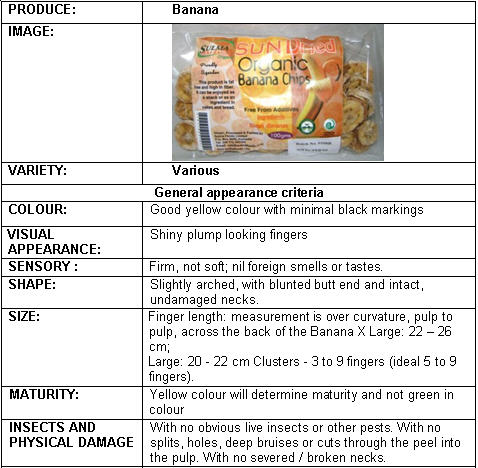 |
| © S. Kahumbu, Kenya |
Bacterial wilt
Initially one of the youngest three leaves turns pale-green or yellow in colour and breaks down at the petiole and the pseudostem. Later all the other leaves collapse around the pseudostem. An infected finger or fruit shows dry and rotted pulp that is coloured brown or black, and the presence of bacterial discharges.
- Use resistant varieties, if available.
- Use certified disease-free planting material.
- Remove infected plants from fields and destroy them.
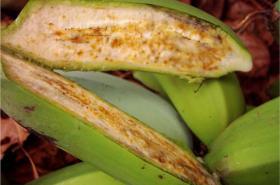
Banana Xanthomonas Wilt Disease
© Dr. Simon Eden-Green (Courtesy of EcoPort, www.ecoport.org)

Bacterial …

Bacterial …
The bunchy top disease
It is a virus disease transmitted by aphids (for more information on aphids click here .) The typical symptoms of bunchy top of banana are very distinctive and readily distinguished from those caused by other viruses of banana. Plants can become infected at any stage of growth and there are some initial differences between the symptoms produced in aphid-infected plants and those grown from infected planting material.
In aphid-infected plants, a few dark-green streaks or dots usually appear on the minor veins and the midrib of the second leaf to emerge after inoculation. They are best seen from the underside of the leaf in transmitted light. The 'dot-dash' symptoms can sometimes also be seen on the petiole. The following leaf may display whitish streaks along the secondary veins when it is still rolled. These streaks become dark green as the leaf unfurls. Successive leaves become smaller, both in length and in width of the lamina, and often have chlorotic, upturned margins. The leaves become dry and brittle and stand more erect than normal giving the plant a rosetted 'bunchy top' appearance.
Suckers from an infected stool can show severe symptoms in the first leaf to emerge. The leaves are rosetted and small with very chlorotic margins that tend to turn necrotic. Dark-green streaks are usually evident in the leaves.
Infected plants rarely produce a fruit bunch after infection and do not fruit in subsequent years. Plants infected late in the growing cycle may fruit once, but the bunch stalk and the fruit will be small and distorted. On plants infected very late, the only symptoms present may be a few dark green streaks on the tips of the flower bracts.
- Eradicate diseased plants. The whole stool, including rhizome/corm and all associated suckers, must be destroyed by uprooting and chopping into small pieces, as the virus can ultimately spread to all parts of the mat. Control must be practiced across the whole production area to avoid the rapid re-infection.
- Use of virus-free planting material
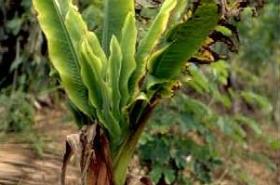
Banana bunchy top virus
© Pearson, M.N. Courtesy of EcoPort, www.ecoport.org

Banana bun…

Banana bun…
Black leaf streak (Mycosphaerella fijiensis) (also called black Sigatoka)
It is a very serious disease that affects the leaves of banana. The spores of this fungus are carried in the wind. The spores germinate in moisture and infect the leaves. The lesions gradually grow larger and kill large areas of the leaf. This results in lower yields and causes the premature ripening of the fruit.
- Remove and destroy diseased leaves, as this will reduce source of infection. If diseased leaves cannot be removed from the plot and burnt, they should be deeply buried.
- Overhead irrigation encourages the disease. Under-canopy micro-irrigation or drip-irrigation is preferable. Plants are also more vulnerable to black leaf streak in sheltered areas where the humidity is high. Good drainage systems that take surface water rapidly out of plantations can reduce humidity.
- Avoid overcrowding of plants.
- Genetic resistance to black leaf streak is a long-term goal for disease management, especially for smallholders who cannot afford to purchase chemicals. Cultivars with high levels of resistance include 'Yangambi KM 5' (AAA), 'Mysore' (AAB), 'Pelipita' (ABB), 'Saba' (ABB) and 'Pisang Awak' (ABB). However, these do not suit all local tastes and some are susceptible to Fusarium wilt (Fusarium oxysporum f.sp. cubense).
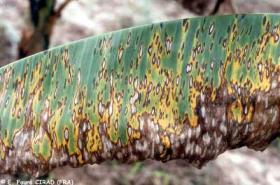
Black leaf streak on banana leaf (also called black Sigatoka)
© INIBAP (www.inibap.org)
Fusarium wilt (Fusarium oxysporum f.sp. cubense) (also called Panama disease)
This is a soil-borne fungus that attacks the roots and blocks the vascular system in the banana, so that the plant wilts. Diseased leaves turn yellow from the margins, dry up and collapse leaving a skirt of dead leaves draped around the plant. There is no effective control for Fusarium wilt, which is spread on infected suckers and in ground water.
- Sanitation and cultural methods can minimise spread of the disease.
- In areas where Fusarium wilt is endemic resistant varieties such as "Cavendish", "Kisigame", "Mararu" and "Uganda green" (plantain) should be grown.
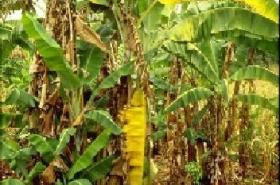
Black leaf streak on banana leaf (also called black Sigatoka)
© INIBAP (www.inibap.org)
The cigar end rot disease (Trachysphaera fructigena)
It is a fungal disease that can attack the ripening fruit of banana, causing a dry rot of the flower end that produces an ash grey wrinkled lesion similar to the burnt end of a cigar. In storage or during transport the disease may progress to involve the whole fruit. Symptoms are: lesions, abnormal shape, visible mould.
The disease is usually of minor significance and seldom requires targeted control.
- Practise sanitation.
- Avoid damage to the fruit and deflower 8-11 days after fruit bunch emergence.
- Bagging of maturing banana stems.
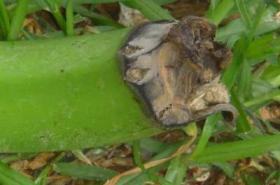
Cigar end rot disease on banana
© Monique Hunziker/BioVision, 2006

Cigar end …

Cigar end …
Anthracnose
It is an important post-harvest problem of bananas especially during transport and storage. On green fruit, pin-size brown or black sunken spots develop. Infection in young fruit is not always manifested until the fruit ripens, when black, round, slightly sunken spots appear. The centres of the spots become dark because of the formation of small black fruiting bodies of the fungus. Under moist conditions, masses of spores are produced having a characteristic salmon (pinkish) colour. Pulp of diseased fruit is usually not affected unless the fruit is over-ripe.
- Practise good field sanitation.
- Minimise bruising during fruit handling
- Hot water treatment of the fruit for 5 min at 50°C. For more information on hot water treatment click here
- Proper sanitation of handling facilities.
- Reports from Philippine claim that sprays of jathropa oil extract at 5000 ppm (5 ml of oil extract in 5 litres of water) significantly controlled anthracnose on bananas and ripening was delayed by 12 days (Philippine Organic Agriculture Information Network, 2004).
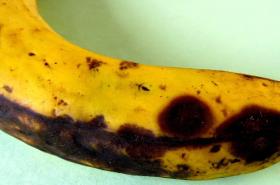
Anthracnose fruit rot on banana
© A.A. Seif, icipe
The burrowing nematode (Radopholus similis)
The burrowing nematode is the most destructive nematode species attacking bananas. Dark patches or spots on the roots indicate nematode infestation. Severely infected plants may show only stubs of rotted roots and may fall down when the bunch has formed. Bananas are also attacked by other nematode species such as Pratylenchus spp., Helicotylencus spp. and Meloidogyne spp.
- Remove infested plants
- Use nematode-free planting material
- Plant resistant cultivars
- Biological control is possible by Paecilomyces lilacinus, a fungus, which parasitises the egg, larva and adult of the nematode.
- All nematode species can also be controlled incorporating neem cake powder into the soil near the banana plants. In Uganda neem extracts spread around the banana plant are recommended for control of nematodes (Karubaga and Kimaru, 1999). For more information on neem click here.
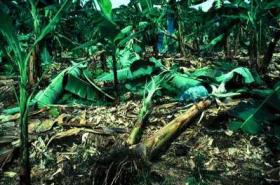
Toppled bananas due to root damage caused by Radopholus similis, the burrowing nematode.
© John Bridge/CAB International. Reproduced from the Crop Protection Compendium, 2005 Edition.

Burrowing …

Burrowing …
Banana weevil borer (Cosmopolites sordidus)
The banana weevil is the most important insect pest of banana. It is about 1-1.5 cm long. The larva (grub) is most destructive: It bores irregular tunnels in the rhizome/corm and pseudostems at ground level. A large proportion of the tissue is destroyed, this reduces the amount of water and nutrients the plants can take up as well as lessening their anchorage. Heavy infestation may kill young plants. Older plants are easily blown over by the wind.
- Chop up the rhizome/corm and pseudo-stem to hasten decomposition, trapping and collection of the adults.
- To prevent an infestation, use non-infested planting material, destroy the shelter and feeding places of the adult weevil and maintain a clean area around the plant mat.
- Some ants are important natural enemies of the banana weevil and are being used for its control.
- Applications of neem powder effectively controlled weevils and nematodes in on-farm trials and in farmers' fields in Kenya. Application of 60 to 100 g of neem seed powder or neem cake at planting and then at 4 months intervals significantly diminished pest damage and increased yields. Application of over 100 g or neem oil was phytotoxic and uneconomical. Neem applications were economical in fertile soils with moderate pest infestation. Neem applications to banana plants grown in poor soil and under very high pest attack were uneconomical.
A combination of good crop management such as application of cow dung and neem treatments resulted in yield increases of 50 to 75% (Musabyimana, 1999).
Dipping suckers in a 20% neem seed solution at planting protects the young suckers from weevil attack by reducing egg laying through its repellent effect on adult weevils. Egg hatching rates may also be lowered in neem-treated plants (Gold and Messiaen, 2000). For more information on neem click here - Hot-water treatment of banana suckers helps against banana weevils. For information on hot-water treatment click here
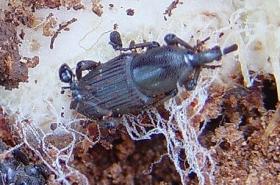
Banana weevil (Cosmopolites sordidus) in banana corm. Adults attain a body lenght of 1-1.6 cm.
© A.M. Varela, icipe
Banana silvering thrips (Hercinothrips bicinctus)
Banana-silvering thrips are small (1.5 mm long), slender, brown insects with pale yellow hind wings that appear as a yellow line down the back of the body when the insect is at rest. Adult thrips have characteristic wings; the transparent wings have a fringe of hairs around the outside edge standing out in the same plane as the wing. The tiny eggs are laid just into the plant tissue on the pseudostem or where 2 fruits touch. The nymphs hatch after 7 or 8 days, are pale yellow or white in colour and often have a black globule of excrement at the end of the abdomen. The larval stage lasts about 10 days after which the nymphs move down into the soil to pupate. Adults emerge after a further 7 to 10 days.
The banana silvering thrips is found in tropical and subtropical regions, they are polyphagous and particularly found on bananas. They feed on the skin of the fruit causing silvering patches (hence the common name of the insect), which turn brown and may cover the whole fruit and deep longitudinal cracks may appear as a result.
- To prevent this insect spreading, do not use planting bits and suckers from areas infested with silvering thrips.
- Bagging of bunches has been found to prevent thrips infestation. Click here for more information on bagging
- Conserve natural enemies. Thrips are attacked by predatory thrips, lacewings and predatory bugs. Avoid use of pesticides that kill natural enemies.
- Whenever necessary spot spray the crop with botanicals or other biopesticides. Some plant extracts (e.g. garlic, rotenone, neem, pyrethrum, and a mixture of garlic and pepper) are reported to control thrips. Spinosad, a bacterial derivative, is effective in controlling thrips.
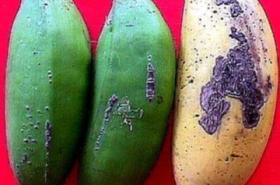
Banana silvering thrips (Hercinothrips bicinctus) damage on banana fruits
© A. M. Varela, icipe

Banana sil…

Thrips
Fruit flies (Bactrocera invadens and Ceratitis rosa)
Two species of fruit flies (Bactrocera invadens and Ceratitis rosa) attack banana in Kenya. Bactrocera invadens is a new species recently discovered in Africa, its 2-3mm in size. This fruit fly is reported attacking banana in Sudan and Kenya and it is a major threat since it leads to rejection of banana in the export market.
One of the most effective control techniques against fruit flies in general is to wrap fruit, either in newspaper, a paper bag, or in the case of long/thin fruits, a polythene sleeve. This is a simple physical barrier to oviposition but it has to be applied well before the fruit is attacked. Little information is available on the attack time for most fruits, but few Bactrocera spp. attack prior to ripening.
Infected fruit on the ground will act as reservoir for re-infestation. If infested fruit reaches the market then maggot infested fruit will be discarded, so allowing emerging adults access to new crop areas.
- Bagging of young banana fruits is an effective method, used in the Pacific and South East Asia for protection against fruit flies. (Personal communication S. Ekesi, AFFI, icipe; Ekesi and Billah, 2006). Click here for more information on bagging
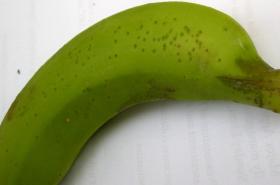
Fruit fly (Bactrocera invadens) attack on green banana
© M. K. Billah, icipe

Fruit fly …

Fruit fly …

Fruit fly
The banana aphid (Pentalonia nigronervosa)
It is a small aphid about 1-2 mm long and blackish-brown in colour. Colonies are usually present on the base of young leaves. The direct damage caused by aphids sucking the plant sap is negligible. However, they are important pests as vectors of the virus causing the bunchy-top disease.
Large colonies of aphids can occur around the base of pseudostems, down to 7-8 cm below the soil surface. Dense colonies can also occur between the sheath of outer leaf and pseudostem. During drought, aphids seek sheltered locations on the plant. In dull and humid weather, however, aphids may spread to foliage generally, and to the bases of maturing hands of fruit and all over the hands of young fruit.
Colonies of P. nigronervosa are attended by ants, which feed on the large quantity of honeydew produced. Many species of ant are involved worldwide. Stechmann et al. (1996) described how ant-attendance reduced the density of indigenous predators of P. nigronervosa considerably, which has implications for biological control (Wellings et al., 1994). Ants also transport aphids from plant to plant, establishing new infestations.
P. nigronervosa is not normally found on plantains, suggesting that they may have resistance to the aphid.
- Conserve natural enemies. They are important in natural control of aphids. For more information on natural enemies click here
- Monitor regularly the crop.
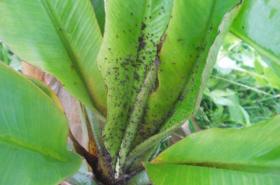
Banana aphids (Pentalonia nigronervosa) often gather on the youngest leaves of young plants. They may form large colonies where they are uncontrolled and protected by ants. They feed by piercing the plant cells with a syringe-like mouthpart.
© www.ctahr.hawaii.edu

Banana aph…

Banana aph…
- Acland, J. D. (1971). East African Crops. FAO. Longman.
- CAB International (2005). Crop Protection Compendium, 2005 edition. Wallingford, UK www.cabi.org
- Foerster, P., Varela, A. and Roth, J. (2001). Best practices for the introduction of Non-Synthetic Pesticides in Selected Cropping Systems. Experiences gained from selected crops in developing countries. With contributions of C. V. Bogulawsky, M. Katua and G. Tarrer. Published by GTZ. Division 45, Rural Development.
- Fruits and Vegetables Technical Handbook. Published by The Ministry of Agriculture and Rural Development, P.O.Box 30028, Nairobi, Kenya. Available from AIC, Kabete, Nairobi
- Karugaba, A. and Kimaru, G.. (1999). Banana Production in Uganda - an essential food and cash crop. Technical Handbook No. 18. Regional Land Management Unit (RELMA). Swedish International Development Cooperation Agency (SIDA). ISBN 9966 896 39 2
- Musabyimana, T., Saxena, R. C., Kairu,E. W., Ogol, C.P.K.O. and Khan, Z. R. (2001). Effects of Neem Seed Derivatives on Behavioral and Physiological Responses of the Cosmopolites sordidus (Coleoptera: Curculionidae). Journal of Economic Entomology 94: 449-454.
- Naturland e.V. www.naturland.de
- Nutrition Data www.nutritiondata.com.
- OISAT, Online Information Service for Non-Chemical Pest Management in the Tropics, Information on Anthracnose. www.oisat.org
- Philippine Organic Agriculture Information Network (2004)
- Souls, J. (2003). Growing bananas. Horticultural Update. Texas Cooperative Extension, Texas A&M University, College Station, Texas. www.aggiehorticulture.tamu.edu
- Tree Crop Propagation and Management. A farmer-trainer training manual. Integration of Tree Crops into Farming Systems Project (ITFSP) GTZ and MoARD (Kenya). October 2002.
- Wellings PW, Hart PJ, Kami V, Morneau DC, 1994. The introduction and establishment of Aphidius colemani Viereck (Hym., Aphidiinae) in Tonga. Journal of Applied Entomology, 118(4/5):419-428.
- Youdeowei, A. (2002). Integrated Pest Management Practices for the Production of Roots and Tubers and Plantains. Integrated Pest Management Extension Guide 3. Ministry of Agriculture (MOFA) Plant Protection and Regulatory Services Directorate (PPRSD), Ghana and German Development Cooperation (GTZ). ISBN 9988 0 1087 7
- Corner Shop, Nairobi cls@mitsuminet.com
- Food Network East Africa Ltd. info@organic.co.ke +254 721 100 001
- Green Dreams. admin@organic.co.ke +254 721 100 001
- Kalimoni Greens. kalimonigreens@gmail,com +254 722 509 829
- Karen Provision Stores, Nairobi. karenstoresltd@yahoo.com +254 20885552
- Muthaiga Green Grocers, Nairobi
- Nakumatt Supermarket info@nakumatt.net +254 20551809
- Uchumi Supermarket: info@uchumi.com +2542 550368
- Zuchinni Green Grocers: Nairobi. +254 204448240
- National Horticultural Research Centre, KARI, Thika. karithika@gmail.com. +2546721281